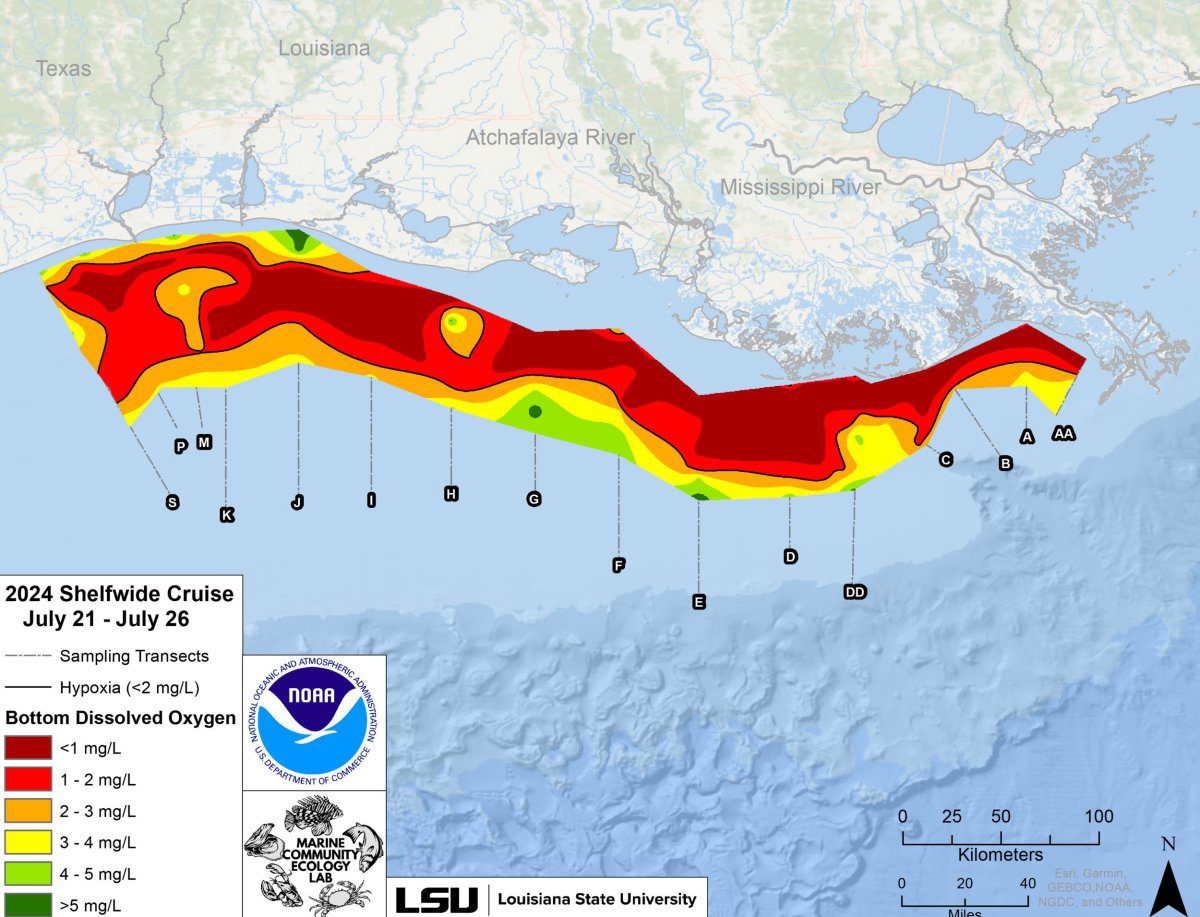Scientists have announced that the Gulf of Mexico’s “dead zone”—where there is so little oxygen that the ocean becomes unsurvivable—is now the size of New Jersey.
Around 6,705 square miles of potential habitat has been wiped out from fish, sea plants, and other ocean life due to water being “hypoxic.” This makes it the 12th largest dead zone recorded in the past 38 years of record-keeping.
The National Oceanic and Atmospheric Administration (NOAA) says its size is larger than predicted for 2024. NOAA and its partners monitor the area annually to track its size and impact, informing mitigation efforts.
“It’s critical that we measure this region’s hypoxia as an indicator of ocean health, particularly under a changing climate and potential intensification of storms and increases in precipitation and runoff,” said Nicole LeBoeuf, assistant administrator of NOAA’s National Ocean Service in a statement.
“The benefit of this long-term data set is that it helps decision makers as they adjust their strategies to reduce the dead zone and manage impacts to coastal resources and communities.”

Map of measured Gulf hypoxia zone, July 21–26, 2024. Red area denotes 2 mg/L of oxygen or lower, the level which is considered hypoxic, at the bottom of the seafloor.
Map of measured Gulf hypoxia zone, July 21–26, 2024. Red area denotes 2 mg/L of oxygen or lower, the level which is considered hypoxic, at the bottom of the seafloor.
NOAA/LUMCON/LSU
Scientists at Louisiana State University and the Louisiana Universities Marine Consortium (LUMCON) off-site link led the annual dead zone survey between July 21-26 as part of collective federal/state efforts to reduce the five-year average to fewer than 1,900 square miles by 2035.
While what they’ve found in the Gulf wasn’t the largest they’ve seen since records began, data points to achieving this target being an uphill struggle.
Most dead zones form annually each summer due to changing environmental conditions. Warmer waters hold less oxygen than cooler water, catalyzing the process.
Warmer waters also increase the metabolism of marine creatures, meaning their need for oxygen paradoxically increases at a time the ocean can’t hold as much.
In this case, the primary culprit is nutrient pollution, particularly from agricultural runoff in the Mississippi River watershed, as far north as St Paul, Minnesota. When it rains, fertilizers and other nutrients from farms wash into the river, which go on to flow into the Gulf of Mexico.
Once there, they cause algae to grow rapidly to the point of self destruction and decomposition, a process that uses up the oxygen in the water. As a result, marine animals either flee the area or die due to the lack of oxygen.

Dr. Jill Tupitza and doctoral student Allison Noble collect near-bottom water aboard Research Vessel Pelican to obtain oxygen measurements used to determine the size of the Gulf of Mexico hypoxic zone.
Dr. Jill Tupitza and doctoral student Allison Noble collect near-bottom water aboard Research Vessel Pelican to obtain oxygen measurements used to determine the size of the Gulf of Mexico hypoxic zone.
LUMCON/LSU, Cassandra Glaspie
The number of known hypoxic pockets of ocean has dramatically increased from 45 identified sites in the 1960s to at least 700 areas today, where some, such as the Gulf, eviscerate their surroundings.
It has been an ecological nightmare for North America’s east coast for some time. Around the world the Baltic States, Japan, and the Korean Peninsula are also significantly affected. The largest in the world lies in the Arabian Sea, covering almost the entire 63,700-square mile Gulf of Oman year-round.
Hypoxic waters also influence the fishing industry, leading to economic losses for communities that depend on fishing for their livelihoods.
Dead zones present broader unsustainable impacts—exposure to low-oxygen habitats has been shown to impact fish diets, growth rates, reproduction, habitat use, and the availability of commercially harvested species like shrimp.

Downtown Saint Paul from the Mississippi River on October 22, 2023 in Minnesota. Fertilizer produced by the area’s agricultural industry is a notable cause of the Gulf of Mexico’s ‘dead zone’.
Downtown Saint Paul from the Mississippi River on October 22, 2023 in Minnesota. Fertilizer produced by the area’s agricultural industry is a notable cause of the Gulf of Mexico’s ‘dead zone’.
AaronP/Bauer-Griffin/GC Images/Getty
However, team are not yet fearful they can limit future damages in order to meet their reduction targets.
In June 2022, the Environmental Protection Agency (EPA) launched the Gulf Hypoxia Program to speed up the Task Force’s nutrient reduction efforts and make significant progress toward the goals outlined in the Gulf Hypoxia Action Plan.
“EPA is committed to its partnership with state and local governments and Tribes in the Mississippi-Atchafalaya River Basin, working together to reduce nutrient pollution and protect the health of the Gulf,” said Bruno Pigott, acting assistant administrator of EPA’s Office of Water, in a statement.
He added: “In fact, thanks to President Biden’s Bipartisan Infrastructure Law, EPA is investing $60 million into this effort.”
Do you have a tip on a science story that Newsweek should be covering? Do you have a question about our ocean? Let us know via [email protected].
Source link : http://www.bing.com/news/apiclick.aspx?ref=FexRss&aid=&tid=66b0ff1272044766b14452518f6fc0e4&url=https%3A%2F%2Fwww.newsweek.com%2Fgulf-mexico-oxygen-mississippi-agriculture-marine-habitat-1934627&c=15358057631093311065&mkt=en-us
Author :
Publish date : 2024-08-05 05:12:00
Copyright for syndicated content belongs to the linked Source.






